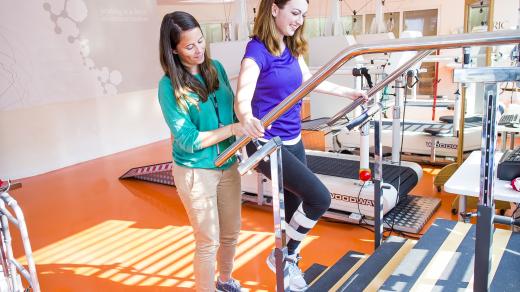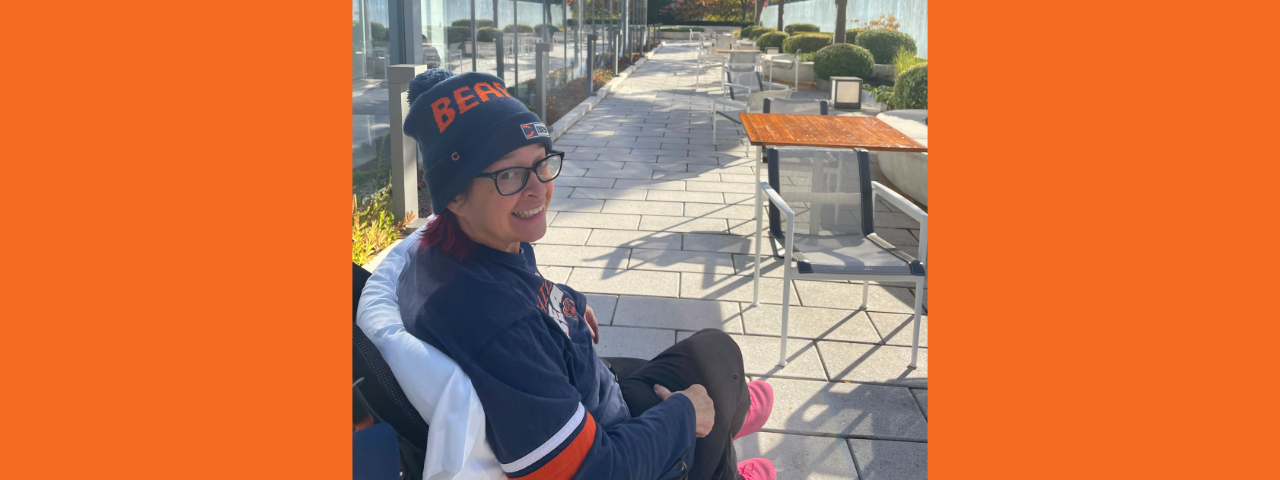“I arrived at RIC in a gurney. The next day, the therapists had me up trying to walk.”
Body
It was St. Patrick’s Day 2014. Jim Osborne, the 45-year-old, “fast-talking” marketing and communications associate was so cold that he was found walking around his building lobby with a blanket wrapped around himself. The next thing he remembered, he was being placed on a gurney.
Jim experienced a brain embolism brought on by infection and was quickly admitted to an acute-care hospital. Jim’s cognitive function was spared, but he was unable to speak or move easily and had trouble putting his thoughts together. While he could understand and acknowledge questions asked of him, responses were difficult and mumbled. After two months, in anticipation for his discharge from the hospital, his sister, a nurse, called dozens of rehabilitation and skilled-nursing facilities.
“There was thought that I would need to go into a home, that I would not improve enough to lead an independent life,” said Jim. “But then an admissions liaison from RIC came to visit me. She asked, ‘do you want to get better?’ From there, I was admitted to RIC under the care of Dr. David Ripley.”
Dr. Ripley and Jim’s therapists were very encouraging while also leveling with him. “This isn’t a sprint,” they’d say. At the onset of his six-week stay, physical, occupational and speech therapists worked with Jim to improve his functioning. Getting up and walking was important for building his strength.
Body
“I arrived at RIC in a gurney. The next day, the therapists had me up trying to walk.” Jim’s physical therapy routine included walking the tenth floor halls and gaining strength by using an exercise bike. During occupational therapy, Jim focused on becoming more independent with his daily routine. He spent time re-learning tasks like getting dressed and progressed to working in the kitchen located in RIC’s Activities of Daily Living (ADL) space. Jim made strong gains in the movement of his hands, which had been affected by the brain injury.
Speech was another area of focus, as Jim confronted aphasia, a disorder that impairs the ability to process and understand language (including speaking, reading and writing). “In the beginning, even though my speech was so bad, a lovely woman would come in and talk to me every day,” said Jim. “It wasn’t until later when I became more aware that I could fully comprehend that she was a speech therapist. She made the environment so comfortable and relaxed during our sessions, and I started to make steady progress.”
I will always remember that day and the sense of freedom I felt.
Jim
Body
Jim will not forget one beautiful June day when his physical therapist, Joe, took him outside for a therapy session.
“This happened when I was really turning a corner, and it was the first time I had walked outside since March,” Jim said. “I will always remember that day and the sense of freedom I felt.”
On a subsequent day, another therapist arranged for Jim’s partner to bring their dogs to RIC, where Jim had an opportunity to spend time playing with them outside.
That July, Jim was discharged from RIC’s flagship hospital, and continued therapy several days a week for the next five months at RIC’s DayRehab Center in Homewood.
“Upon discharge from DayRehab, I was a totally different person than when I initially arrived at RIC,” said Jim. “In the beginning, I couldn’t even look up when asked to do so. I couldn’t find the right words for basic, everyday items. It’s amazing to think about how the brain can heal, and to reflect on my progress today. There’s no better place than RIC for this level of recovery.”
Today, Jim continues to hit milestones. He recently rode a bike for the first time in several years, and passed his driving exam. Jim’s relationship with RIC didn’t stop at discharge. Initially, he became engaged with RIC’s conversation groups offered by the Center for Aphasia Research & Treatment, where he had an opportunity to discuss art and books with others who have aphasia.
Recently, Jim began volunteering twice a week at RIC on the tenth floor, where he provides assistance to therapists and visits with patients who are working to overcome brain injuries. “I wanted to give back, and I love having an opportunity to help patients,” he said. “I listen to them and share my story, reminding them that it gets better and better every day.”


